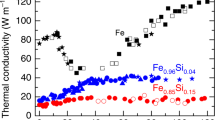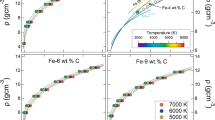Abstract
THE temperature distribution in the Earth's core places important constraints on the Earth's internal heat budget and on models of the geodynamo. The solid inner core crystallizes from a liquid outer core, consisting mainly of iron alloyed with a lighter element, at a depth of about 5,100 km (corresponding to a pressure of about 3.3 Mbar). Thus, the most reliable means of determining the temperature gradient in the core is to estimate the melting temperature of iron and iron-rich compounds at the pressure of the inner core boundary. Current estimates range from about 4,000 to 8,000 K; but these estimates, obtained from shock compression1–3, theory (discussed in ref. 4) and extrapolation of static pressure data2,3,5, are poorly constrained. Here I present melting-point measurements on iron and iron–oxygen compounds at static pressures of up to Mbar. Extrapolation of these results to 3.3 Mbar yields a temperature at the inner-core boundary of 4,850±200 K. A weak change in optical absorption observed above 2,000 K may correspond to the solid–solid phase transition found in shock experiments at 2 Mbar (ref. 1).
This is a preview of subscription content, access via your institution
Access options
Subscribe to this journal
Receive 51 print issues and online access
$199.00 per year
only $3.90 per issue
Buy this article
- Purchase on Springer Link
- Instant access to full article PDF
Prices may be subject to local taxes which are calculated during checkout
Similar content being viewed by others
References
Brown, J. M. & McQueen, R. G. J. geophys. Res. 91, 7485–7494 (1986).
Williams, Q., Jeanloz, R., Bass, J., Svendsen, B. & Ahrens, T. J. Science 236, 181–182 (1987).
Williams, Q., Knittle, E. & Jeanloz, R. J. geophys. Res. 96, 2171–2184 (1986).
Anderson, O. L. Geophys. J. R. astr. Soc. (1986).
Boehler, R., von Bargen, N. & Chopelas, A. J. geophys. Res. 95, 21731–21736 (1990).
Ringwood, A. E. & Hibberson, W. Phys. Chem. Miner. 17, 313–319 (1990).
Shen, G., Lazor, P. & Saxena, S. K. Phys. Chem. Miner. (in the press).
Lazor, P., Shen, G. & Saxena, S. K. Science. (in the press).
Yoo, C. S., Akella, J. & Ruddle, C. M. Eos, 64 (1992).
Boehler, R. Geophys. Res. Lett. 13, 1153–1156 (1986).
Ross, M., Young, D. A. & Grover, R. J. geophys. Res. 95, 21713–21716 (1990).
Boehler, R. Earth planet. Sci. Lett. 111, 217–227 (1992).
Birch, R. Geophys. J. R. astr. Soc. 29, 373–387 (1972).
Lui, L. Geophys. J. R. astr. Soc. 43, 697–705 (1975).
Ohtani, E., Ringwood, A. E. & Hibberson, W. Earth planet. Sci. Lett. 71, 94–103 (1984).
Kraut, E. A. & Kennedy, G. C. Phys. Rev. Lett. 16, 608–609 (1966).
Boehler, R. Phys. Rev. 27, 6754–6762 (1983).
Chopelas, A. & Boehler, R. Geophys. Res. Lett. 19, 1983–1986 (1992).
Mao, H. K., Bell, P. M., Shaner, J. W. & Steinberg, D. J. J. appl. Phys. 49, 3276–3283 (1978).
Author information
Authors and Affiliations
Rights and permissions
About this article
Cite this article
Boehler, R. Temperatures in the Earth's core from melting-point measurements of iron at high static pressures. Nature 363, 534–536 (1993). https://doi.org/10.1038/363534a0
Received:
Accepted:
Issue Date:
DOI: https://doi.org/10.1038/363534a0
This article is cited by
-
Imaging the top of the Earth’s inner core: a present-day flow model
Scientific Reports (2024)
-
Materials under extreme conditions using large X-ray facilities
Nature Reviews Methods Primers (2023)
-
Progress in the numerical modeling of mantle plumes
Science China Earth Sciences (2023)
-
Determination and comparison of the electrical and thermal transport properties of BCC and FCC Fe–Ni based ternary alloys in the Earth’s inner core
Journal of Earth System Science (2022)
-
Thermal conductivity of iron and nickel during melting: Implication to the planetary liquid outer core
Pramana (2022)
Comments
By submitting a comment you agree to abide by our Terms and Community Guidelines. If you find something abusive or that does not comply with our terms or guidelines please flag it as inappropriate.



